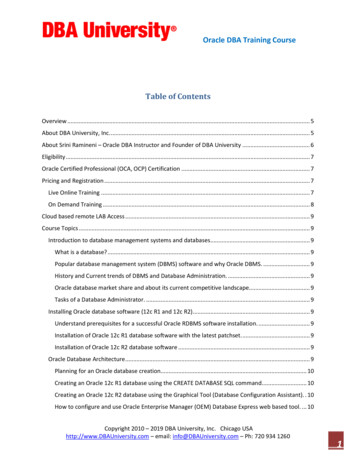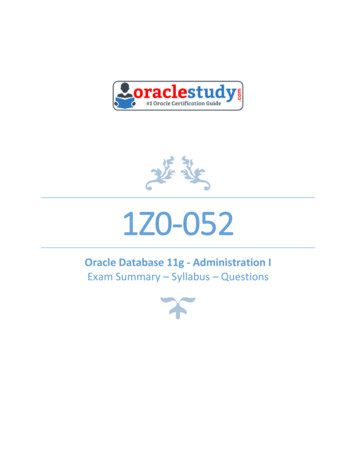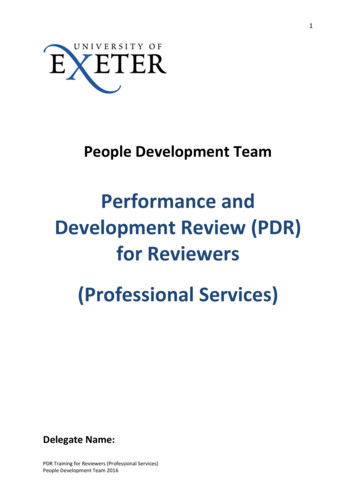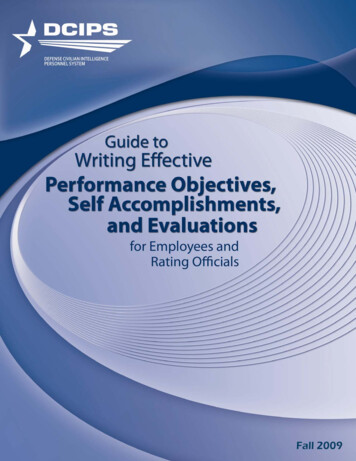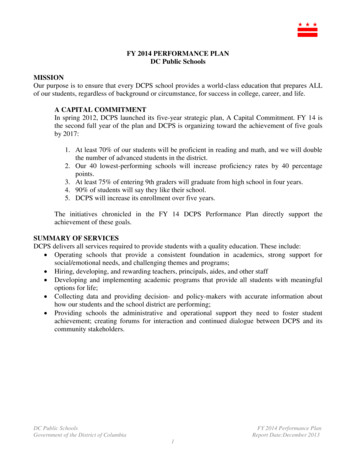
Transcription
FY 2014 PERFORMANCE PLANDC Public SchoolsMISSIONOur purpose is to ensure that every DCPS school provides a world-class education that prepares ALLof our students, regardless of background or circumstance, for success in college, career, and life.A CAPITAL COMMITMENTIn spring 2012, DCPS launched its five-year strategic plan, A Capital Commitment. FY 14 isthe second full year of the plan and DCPS is organizing toward the achievement of five goalsby 2017:1. At least 70% of our students will be proficient in reading and math, and we will doublethe number of advanced students in the district.2. Our 40 lowest-performing schools will increase proficiency rates by 40 percentagepoints.3. At least 75% of entering 9th graders will graduate from high school in four years.4. 90% of students will say they like their school.5. DCPS will increase its enrollment over five years.The initiatives chronicled in the FY 14 DCPS Performance Plan directly support theachievement of these goals.SUMMARY OF SERVICESDCPS delivers all services required to provide students with a quality education. These include: Operating schools that provide a consistent foundation in academics, strong support forsocial/emotional needs, and challenging themes and programs; Hiring, developing, and rewarding teachers, principals, aides, and other staff Developing and implementing academic programs that provide all students with meaningfuloptions for life; Collecting data and providing decision- and policy-makers with accurate information abouthow our students and the school district are performing; Providing schools the administrative and operational support they need to foster studentachievement; creating forums for interaction and continued dialogue between DCPS and itscommunity stakeholders.DC Public SchoolsGovernment of the District of ColumbiaFY 2014 Performance PlanReport Date:December 20131
PERFORMANCE PLAN DIVISIONS12 Office of Teaching and Learning3 Office of Human Capital Office of Specialized Instruction4 Office of the Chief of Schools5 Office of Family and Public Engagement Office of Data & Strategy6 Office of the Deputy Chancellor for Operations7AGENCY WORKLOAD MEASURESMetric# of Title I schools% of students qualified for Free or Reduced Lunch1FY 2011Actual9676%FY 2012Actual9970%FY2013Actual9877%8Every year the Mayor publishes a budget book detailing spending by agency for the upcoming fiscal year. To ensureconsistency and parity across agencies, the budget book publishes data regarding agency “activities.” These refer toinitiatives within a cost center. For instance, the budget for the Office of the Chief Financial Officer (cost center) ispresented in terms of accounting operations, budget operations, and CFO operations (activities). At DCPS, an agencysupporting numerous offices and initiatives, this method can appear opaque to some readers. For example, the Office ofHuman Capital has no mention in the FY 2014 DCPS agency budget chapter. Instead, that office’s budget is represented bythe following activities: Labor Management & Partnerships Master Educators Personnel School TransformationThese activities do not present a clear picture of the office, whose mission is to ensure that DCPS has the most effectiveteachers, principals, and central office staff in the nation. As such, we have organized this plan by office.2In September 2013, DCPS finalized a reorganization of several central office functions and reporting structures. This listof divisions reflects the organization’s new organizational chart (attached). Once the budget reprogramming for thesechanges is final, DCPS will update the Office of the City Administrator with a cross-walk of these reporting structurechanges to the FY2014 budget book upon request.3The Office of Teaching and Learning (OTL) is a new division in FY14. This new office was created to focus on theprevious Office of the Chief Academic Officer’s Common Core implementation work.4The Office of Specialized Instruction is a new division in FY14. It was created to expand the work of the Office of SpecialEducation to include two teams previously part of the Office of the Chief Academic Officer – the Office of BilingualEducation and the Office of Early Childhood Education – and to ensure greater alignment between these teams.5The Office of the Chief of Schools has an expanded role in FY14 which includes the work of two teams previously part ofthe Office of the Chief Academic Officer – the Office of Youth Engagement and the Office of Career and CollegeReadiness – to ensure better alignment between these teams.6The Office of Data & Accountability and Office of Strategy were merged and renamed the Office of Data & Strategy tomore closely align the new office’s data, strategy and accountability functions.7The Office of the Deputy Chancellor for Operations is a new division in FY14. It combines the work and objectives oftwo previous DCPS divisions – the Chief of Staff and the Office of the Chief Operating Officer – to ensure better alignmentbetween these two teams.8Part of the change in students eligible for Free/Reduced Lunch is because some schools have been certified for theCommunity Eligibility Option, under which all students receive lunch meals at no charge.DC Public SchoolsFY 2014 Performance PlanGovernment of the District of ColumbiaReport Date:December 20132
Office of Teaching and LearningSUMMARY OF SERVICESThe Office of Teaching and Learning delivers high-quality instructional resources, enhance classroompractice and scale effective programs to increase DCPS student achievement and prepare all studentsfor success in college, career, and life.OBJECTIVE 1: Implement a rigorous, relevant, college preparatory curriculum that gives allstudents meaningful options for life. (One City Action Plan Actions 2.2.2, 2.2.4, 2.2.5, 2.2.6 andIndicator 2D).INITIATIVE 1.1: Develop core curricular resources for continued support of theCommon Core Standards implementation. (One City Action Plan - Actions 2.2.4, 2.2.5,2.2.6 and Indicator 2D)Over the last two years, DCPS has undertaken a district-wide alignment to the Common CoreState Standards (CCSS) – instructional standards which map what a student needs to know tobe ready for college and careers. A major focus of the district’s CCSS work in SY2013-2014will be to increase the amount of curricular resources (e.g. texts, textbooks, etc.) for ourschools, including detailed unit plans. Through the Common Core Reading Corps CurriculumFellowship, DCPS teachers and coaches will work to create a more detailed, robust anddescriptive curriculum. Similarly, in Science, Technology, Engineering and Math (STEM),DCPS will continue to acquire and create resources (e.g. texts, textbooks, and consumables)aligned to the CCSS. The next phase of this work will be complete by June 30, 2014.INITIATIVE 1.2: Implement a focused literacy strategy and provide targeted supports toaccelerate reading achievement.Since reform efforts began in 2007, DCPS has made great strides in reading. Yet, over half ofstudents attending DC Public Schools cannot read on grade level. DCPS rolled out anintegrated academic plan in SY 2011-2012 and is accelerating this work in SY2013-2014. Tothat end, DCPS will support all elementary schools in a chosen literacy focus area withresources and regular professional development. Targeted schools will receive additionalliteracy personnel (e.g. Assistant Principals of Literacy, Reading Specialists) whose work willbe overseen by the Office of Teaching & Learning. DCPS will also begin implementing theCommon Core Writing Standards at the elementary level. This work will be complete by June30, 2014.INITIATIVE 1.3: Increase access to advanced and enriched programming in our schools.DCPS has set a goal to increase in the number of students scoring at the advanced level on theDC CAS. In pursuit of this goal, DCPS continues to increase access to high quality collegepreparatory curricula and advanced and enriched programming in our schools. For instance,DCPS will provide teachers at targeted schools training on implementing Enrichment Clustersfor high ability students. In addition, the district will continue to offer DCPS Advanced ReadersExtensions (DARE) – previously called Advanced Readers Extension Modules – so thatEnglish/Language Arts teachers in grades 2-5 can offer advanced readers an enrichmentextension to their regular circular units. Finally, DCPS will direct more resources intoprocuring commercially-produced programming (e.g. Junior Great Books) for high abilityDC Public SchoolsGovernment of the District of ColumbiaFY 2014 Performance PlanReport Date:December 20133
students to maximize their experience in DCPS schools. This work will be complete by June30, 2014.INITIATIVE 1.4: Increase access to rigorous Advanced Placement courses in schools.DCPS graduates must be prepared to succeed in postsecondary education. To that end, DCPS isincreasing access to and quality of Advanced Placement courses. DCPS will partner with theCollege Board to provide teachers year-round professional development on targeted AP coursesto increase the quality of instruction. By leveraging the College Board’s “AP Potential”selection tool, DCPS will also identify more students for AP courses. This work will becomplete by June 30, 2014.OBJECTIVE 2: Retain the most highly effective and highly compensated educators in thecountry.INITIATIVE 2.1: Provide schools with high quality instructional coaches.In FY14, DCPS will support a strategic recruitment and staffing campaign to recruit and selecthigh quality instructional coaches to serve in our schools, with particular attention to aligningefforts to each school’s SY2013-2014 literacy focus area. DCPS will work to ensure that allinstructional coaches have a strong knowledge base of the literacy content areas throughregular professional development and in-depth training on literacy focus areas over the summerprior to the school year. This work will be complete by September 30, 2013.INITIATIVE 2.2: Train and support coaches on running Collaborative and IndividualLearning Cycles on schools’ literacy focus areas.Research shows that stand-alone workshops simply do not change instructional practice. Assuch, our instructional coaches use Individual and Collaborative Learning Cycles (CLCs) toembed training in the daily work of teachers. The Office of Teaching & Learning will prepareall instructional coaches on literacy focus areas during summer 2013, particularly on how touse the data connected to schools’ literacy focus areas, so that coaches run effective CLCs onthe focus areas throughout SY2013-2014. This work will be complete by June 30, 2014.DC Public SchoolsGovernment of the District of ColumbiaFY 2014 Performance PlanReport Date:December 20134
KEY PERFORMANCE INDICATORS – Office of Teaching & LearningFY 2012ActualFY2013TargetFY 2013ActualFY 2014ProjectionFY 2015ProjectionFY 2016Projection% of students proficient oradvanced in reading on DC CAS[One City Action Plan 2.2.5]943%N/A1047%51%N/A11N/A% of students proficient oradvanced in math on DC CAS [OneCity Action Plan 2.2.5]46%N/A50%53%N/AN/AReading achievement gap (%proficient or advanced) betweenblack and white students55%46%54%49%N/AN/AMath achievement gap (%proficient or advanced) betweenblack and white students52%49%51%49%N/AN/A% of HS students taking at least 1AP exam22%24%23%24%26%28%% of AP exams passed30%33%31%33%36%39%Measure9As of 2013, the Office of the State Superintendent of Education (OSSE) no longer reports aggregate DC CAS proficiencyrates by elementary and secondary because of the district’s waiver from No Child Left Behind which designated theseaggregations. Instead, OSSE reports district-wide proficiency rates. These KPIs have been modified to conform to this citywide change. .10Because of the modification to this data reporting by OSSE occurred in 2013, there was no target set using the newreporting aggregation when this report was submitted in 2012.11In 2015, DC will transition from the DC CAS to the Partnership for the Assessment of Readiness in College and Careers(PARCC) assessments. PARCC is a group of 20 states working together to develop a common set of K-12 assessments inEnglish language arts/literacy and mathematics anchored in what it takes to be ready for college and careers. Once baselinedata for PARCC is available in 2014, DCPS will provide projections for future years.DC Public SchoolsFY 2014 Performance PlanGovernment of the District of ColumbiaReport Date:December 20135
Office of Human CapitalSUMMARY OF SERVICESThe Office of Human Capital (OHC) works to ensure that DCPS has the most effective teachers,principals and central office staff in the nation. Its work is organized into the following four activities: Teacher Effectiveness: Responsible for recruitment, selection, and onboarding of new teachers,as well as the evaluation, development, recognition, and retention of classroom teachers andother school staff Principal Effectiveness: Responsible for recruitment, selection, and onboarding of new schoolleaders, as well as the evaluation, development, recognition, and retention of school leaders Central Office Effectiveness: Responsible for recruitment, selection, and onboarding of newCentral Office staff, as well as the evaluation, development, recognition, and retention of staff Human Resources: Responsible for providing outstanding customer service to DCPSemployees on all staffing, benefits, payroll, and other related issuesOBJECTIVE 1: Develop and retain the most highly effective and highly compensated educatorsin the country, and recognize and reward their work (One City Action Plan Action 2.2.6).INITIATIVE 1.1: Recruit and select the best possible teacher talent.In FY14, DCPS will significantly expand recruitment capacity to support principals in hiringgreat talent, with a particular focus on an elite corps of veteran teachers known as the CapitalCommitment Fellowship. OHC will use social networks, videos that profile DCPS schools andstaff members, and create partnerships with local universities to attract talent. OHC willcontinue to revise and implement its teacher selection model using IMPACT data to determinewhat parts of the selection process are most predictive of success in the classroom and byseeking feedback from principals and candidates on the selection process. This work will becompleted by June 30, 2014.INITIATIVE 1.2: Rigorously evaluate teacher performance.In order to ensure valid data on employees, DCPS will continue to implement the IMPACTevaluation system with fidelity. OHC will provide school leaders and Master Educators withinstructional templates to guide their assessment of the 9 Teach standards that underpin theevaluation system. OHC will develop and maintain videos of instruction that have been normedby Master Educators and school leaders and train and assess their assessment of the 9 TeachStandards. This work will be complete by September 30, 2014.INITIATIVE 1.3: Retain the best teacher talent.Now that IMPACT allows DCPS to identify the highest performers, the district must investrenewed energy in recognizing and retaining them. The centerpiece of this work will continueto be the LIFT (Leadership Initiative for Teachers) career ladder system. DCPS will continueperformance pay, including aligning compensation structure for WTU members to the LIFTcareer ladder. DCPS will also design and implement new initiatives to support teacherleadership in schools, including piloting new teacher leadership roles and implementing teacherleadership roles over the course of the SY2013-2014. This work will be complete by June 30,2014.DC Public SchoolsGovernment of the District of ColumbiaFY 2014 Performance PlanReport Date:December 20136
INITIATIVE 1.4: Provide Master Educator pedagogical support to the 40 targetedschools.Quality of instruction in the 40 lowest-performing schools will drive overall achievementgrowth (Goal 2 of A Capital Commitment). OHC will extend its investment in high qualityincumbent and new educators by providing Master Educator pedagogical support for newteachers in the 40-targeted schools at the beginning of the year, optional CLCs by content area,and intensive coaching support throughout SY2013-2014. This work will be complete by June30, 2014.INITIATIVE 1.5: Recruit and select the best possible school leadership talent.DCPS will significantly expand school leader recruitment capacity with a particular focus onthe 40 targeted schools. In SY2013-2014, DCPS will focus on filling principal vacancies withoutstanding, external and internal talent with the intention of a majority of principal candidatescoming from the AP ranks in future school years. To build the pipeline of future principals,OHC will revise its selection model for principals, APs, and instructional superintendents,using School Leader IMPACT data to determine what parts of the selection process are mostpredictive of success in the classroom. In addition, OHC will continue to support the Mary JanePatterson Fellowship inaugural cohort so each Fellow earns a principal ship for SY2014-2015,and will launch the second cohort in January 2014. This work will be complete by June 30,2014.INITIATIVE 1.6: Retain the best school leader talent.DCPS will implement an aggressive performance-based salary scale for APs, and a bonussystem for all Highly Effective school leaders, including special incentives to serve in the 40targeted schools. DCPS will also continue to target training and support to existing schoolleaders in a number of ways, including high quality Leadership Academy sessions for allprincipals, using external experts to provide high-quality professional development to existingschool leaders, and continuing to support and assess the effectiveness of the Executive Mastersin Leadership (EML) program at Georgetown University for selected DCPS principals. Thiswork will be complete by June 30, 2014.OBJECTIVE 2: Provide schools with the central office support they need to foster studentachievement.INITIATIVE 2.1: Provide efficient and customer service oriented Human Resources.To ensure that DCPS employees are provided outstanding customer service, the Office ofHuman Capital will maintain its current HR Answers helpline, which includes both a phonenumber and email address to receive inquiries each day. We will also proactively provide moreinformation to our employees via our website, including information about basic HR policiesand procedures, benefits, retirement, compensation, and union contracts. We will measure oursuccess toward this goal by surveying our employees annually.INITIATIVE 2.2: Continue to streamline, improve and procure new technologyinfrastructure to support efficient customer service.In FY14, the Office of Human Capital will continue to collaborate with DCHR and OCTO toupgrade/enhance technology systems, including PeopleSoft (PS), the talent, selection, hiring,DC Public SchoolsGovernment of the District of ColumbiaFY 2014 Performance PlanReport Date:December 20137
and on-boarding tool’s (TSHO’s) tracking and reporting functionality, and an electronicapplication system for the Teacher’s Retirement Plan. OHC will also create a new Quickbase(QB) Separations database and will collaborate with eSchool Solutions (vendor for substituteplatform) to enhance SmartFind Express to include subject-area expertise and a pool ofcandidates dedicated to the targeted 40 schools. This work will be complete by June 30, 2014.KEY PERFORMANCE INDICATORS – Office of Human CapitalMeasureFY 2012ActualFY 2013TargetFY 2013ActualFY 2014ProjectionFY 2015ProjectionFY 2016ProjectionRetention rate of teachers ratedhighly effective on Percentage of teachers HighlyQualified12# HR constituent cases open50 days12Highly Qualified is defined in the legislation authorizing No Child Left Behind as a teacher holding abachelor’s degree an
of divisions reflects the organization’s new organizational chart (attached). Once the budget reprogramming for these changes is final, DCPS will update the Office of the City Administrator with a cross-walk of these reporting




